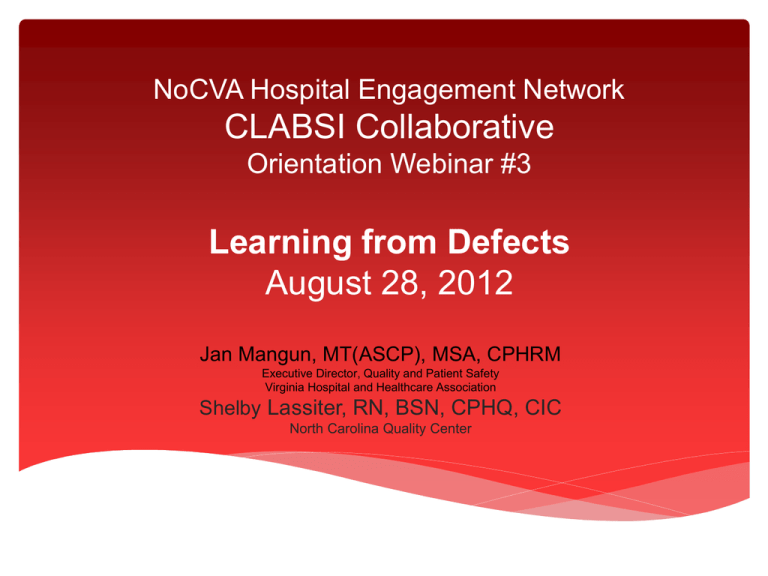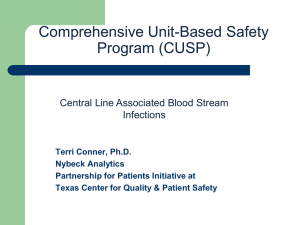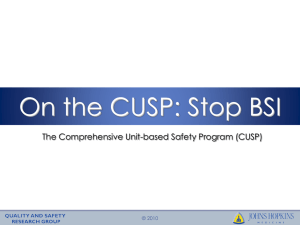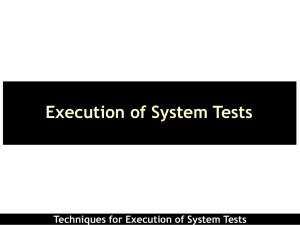Presentation - North Carolina Quality Center
advertisement

NoCVA Hospital Engagement Network CLABSI Collaborative Orientation Webinar #3 Learning from Defects August 28, 2012 Jan Mangun, MT(ASCP), MSA, CPHRM Executive Director, Quality and Patient Safety Virginia Hospital and Healthcare Association Shelby Lassiter, RN, BSN, CPHQ, CIC North Carolina Quality Center Partnership for Patients Goals • By the end of 2013, preventable hospital acquired conditions would be reduced by 40%, compared to 2010 Adverse Drug Events CLABSI OB Adverse Events SSI’s VAP CAUTI Falls Pressure Ulcers VTE • By the end of 2013, 30-day hospital readmissions would be reduced by 20%, compared to 2010 The CLABSI Collaborative is designed to impact the CLABSI Reduction P4P goal 2 Objectives Participants will be able to: 1. Describe how defect analysis is a foundational element of CUSP. 2. Define “defect.” 3. Describe at least two concepts about why defects occur. 4. Describe the five steps in analyzing a CLABSI as a defect and discuss techniques related to each. What is a Defect ? Defect: • Any clinical or operational event or situation that you would not want to happen again. May include events that you believe actually caused harm or put patients at risk for significant harm. Johns Hopkins’s “Learning from Defects” tool. Appendix 6 of On the CUSP: Stop BSI toolkit at http://www.onthecuspstophai.org/on-thecuspstop-bsi/ Accessed 8/24/12 Definitions Defect Analysis: -the process of analyzing a defect to determine its root cause. Defect Prevention: -the process of addressing root causes of defects to prevent their future occurrence. Lanier K. Experiences In Root Cause Analysis and Defect Prevention Methods. Presentation publically available at http://www.dtic.mil/ndia/2004cmmi/CMMIT5Tue/Root_CauseAnalysis.pdf Accessed April 2010. The Five Steps of CUSP 1. Educate on the Science of Safety (7/31/12 webinar) 2. Identify defects (today) 3. Engage leadership (now and future) 4. Continue to learn from defects (today) 5. Teamwork and communication (now and future) CUSP Step 2: Identifying Defects • Through reports – HAI (CLABSI) reports from Infection Prevention and staff, med error reports, incident reports, etc. • Patient and family feedback • Gemba walks • Unit monitors • Staff feedback, sharing information in a psychologically friendly environment, asking, “How will the next patient be harmed?” • Reporting of “near misses” http://www.onthecuspstophai.org/on-the-cuspstop-bsi/toolkits-and-resources/#cusp CUSP Step 4: Learning from Defects 1. What happened? 2. Why did it happen? 3. How will you reduce the likelihood of it happening again? 4. How will you know the risk is reduced? 5. With whom should you share the learning? It’s All About Prevention Learning from defects: •Reduces the likelihood of the event reoccurring and causing harm. •May occur in two important areas: o System design o Human behavior •Provides structure and consistency. •Allows learning from common cause and special variations. •Allows prevention further “upstream” from the untoward outcome (CLABSI) to make care even safer. Why is this Important? • Reimbursement systems are being reengineered to reward the best performers (no margin, no mission, no salary, no job…) • Growing transparency of outcomes – public reporting • Defects are expensive in many ways… • Excellence in care - learning from each defect is the best way to prevent it from reoccurring. • The Golden Rule-it’s what we’d want done for us or the person we love most! Background Concepts 1. Normalized deviance: • Long-term phenomenon in which individuals or teams repeatedly accept a lower standard of performance lower standard becomes the “norm.” • Deviation from SOP becomes routine practice and is “normalized.” becomes acceptable may no longer even be recognized as deviation. (Just Culture “behavioral drift”, at-risk behavior) • Allowed because we get away with it…most of the time… Normalized Deviance in Real Life • I (Shelby) have three rescue dogs, all my furry children that I love dearly. However, I put one of them, Bindi Sue, in a life-threatening situation one day. I was practicing normalized deviance: any dog owner knows that allowing your dog to ride in a motor vehicle with their head out the window is asking for disaster. I did it because Bindi loved it. One day, we were riding in my SUV with the windows rolled down and when I made a left-hand turn, it pitched Bindi out of the back window into a busy intersection. After a trip to the vet, she was officially deemed OK but I could have easily killed my beloved Bindi. • Now as you listened to this story, what were you thinking? “Gosh, I’ve done the same thing.” or “How stupid can you be? Didn’t you know better?” or “I remember when I did something like that…” It got you to thinking about situations you may have been in that could have resulted in a pet’s or child’s harm maybe. My telling my story helps others to realize that we all do things we may know are not the best practice. But, we get away with it, most of the time. What are some deviances you’ve normalized? • Speeding? • Leaving written passwords in clear view around your computer? • Not getting your dryer vent cleaned routinely? • What are some other things? CLABSI “SUV Rides” • Inconsistent hand hygiene practices? • Not disinfecting access ports “swabbing the hub” on IV when entering for medication administration or not swabbing for at least 15 seconds? • Not “CUSS’ing” when a provider is not following proper central line insertion bundle protocols or you see a peer breech central line maintenance standards? • What are some others? Excuses to Deviate • • • • • • • • • “The rule(s) is stupid” Rule or reason for it is unknown New technology Complexity of work Rule does not apply to this patient “Rule(s) doesn’t apply to me” “I know a better way” Healthcare worker is not the one at risk Competing priorities: o Cost and time, o Culture (politics, hierarchy, lack of communication openness, etc.) • “It won’t hurt anything this one time…” Background Concept 2: Errors in Complex Systems • When dealing with complex systems, such as healthcare, we have both sharp end and blunt end factors. • The “sharp end” refers to the personnel or parts of the health care system in direct contact with patients. Personnel operating at the sharp end may literally be holding a scalpel (eg, an orthopedist who operates on the wrong leg) or figuratively be administering any kind of therapy (eg, a nurse inserting a Foley) or performing any aspect of Foley care. This is where active failures can occur. • The blunt end refers to the background of policies, administrative priorities, process designs, etc. where decisions are made that impact the sharp end “downstream.” This is where latent failures occur and most often where the root cause of an active failure may be found. Active Failures • Active failures: failures that occur at the point of contact between a human and some aspect of a larger system (e.g., a human-machine interface). o readily apparent (e.g., pushing an incorrect button, not following sterile technique to change a CL dressing) o involve someone at the frontline or “sharp end”. Latent Failures • Latent Failures: less apparent failures of organization or system/process design that contribute to the occurrence of errors or allowed them to cause harm to patients. o Occurrences are at the “blunt end” but may result in active failures on the “sharp end.” o AKA: “Accidents waiting to happen.” Reason JT. Human Error. New York, NY: Cambridge University Press; 1990. Background Concept 3: Timing of Analysis Analysis of a defect should occur as soon as possible after the defect is recognized. The best light is often that from a burning bridge… ~Don Henley The best learning from a defect occurs before the “light goes out.” Two important terms: • Gemba walk: A Japanese term used in Lean methodology that means, “the real place.” In a business sense, it refers to the place where value is created. o observation where the work is actually carried out, such as on the nursing unit, learn both what the actual problems are and the best solutions for those problems. o activity that takes management to the point of care to find ground truth • Ground truth: Information that is collected on location and used to compare reality to perception. Tips on Learning from each Defect • Use some type of standard investigation tool • Utilize a multidisciplinary team (Unit CUSP Team) • Investigate details prior to meeting • Build on Current Process. (“mini-RCA”, a “deep dive” etc.) • Don’t be afraid to really challenge practice and traditional ways of thinking! • Environment of psychological safety is critical. Basic steps in the “L-from-D” Process 1. What happened? 2. Why did it happen? 3. How will you reduce the likelihood of it happening again? 4. How will you know the risk is reduced? 5. With whom should you share the learning? Case Study •44 y.o. female w/ colon CA admitted to your med/surg ICU on 7/12/12 with diarrhea and severe dehydration. •She is S/P partial colectomy and has a colostomy. •She was in process of completing her 3rd round of chemotherapy prior to admission. •CL inserted 7/12 in Rt. subclavian for hydration and to monitor CVP. •On 7/19, she became hypothermic w/a temp of 957F and hypotensive. •BC Gram stain + for gram negative rods. BCs + for E. coli on 7/20. •CXR - for pneumonia. Other cultures −. Step 1: What Happened? • Use a standard event investigation format. (See CLABSI Event Report template as an example). • Tool should be easy to use. • No perfect tool so use what works but include information to assess for active and latent errors. • Must establish a chronological order of events and data related to the event. • Usually requires some research and gemba walks. • One person should not do all the research or gemba walks. (Science of Safety principle: Teams make wise decisions when there is diverse and independent input.) Example of an Event Investigation Tool • • • • • • • • • • • • • • Patient: JJ MR No: 29292999 Admit Date: 7/12/12 Diagnosis:. Colon cancer, receiving 3rd round of chemo, has colonoscopy s/p partial colectomy Infection Date: 7/19/12 Criteria: Hypotension, hypothermia, +BC Organism: E. coli CVC Insertion Info Date CVC Removed: 7/20/12 Insertion Site: Rt subclavian Type of Line: TLC Was insertion bundle used and were all elements complied with when CVC inserted? YES__X__ NO_____ If NO, explain: Who Inserted: Dr. McSwain, intensivist Patient Information and CVC Care Practices 1 Patient’s location/room number(s) 3415 What have we learned from Event Report Tool? 1. E. coli grown in blood from BC done 7 days after admission and 7 days after CL was inserted. 2. Patient was immunocompromised with leukopenia (WBC 2 on adm.) 3. Patient was having severe diarrhea 4. Pool nurse staffing used more than desired Step 1: Example Additional information needed: •How is environmental room cleaning done? How often? •What is our patient hygiene like, including hand hygiene? •What is compliance to “scrub the hub” since the educational push? Has it fallen off? •What is our true hand hygiene compliance rate? •How was the diarrhea managed? Additional Learning… • Direct patient-contact environmental surfaces are not cleaned in occupied beds by EVS. • Unit staff use bath basins to give bed baths; they rinse basins after use and allow to dry. UM saw one pool RN giving a bath from the sink during one gemba. UM did a lit review on IPH. • Diarrhea management was difficult w/many spills onto bed and patient. No WOCN on staff at hospital to help. They used the largest colostomy bags the hospital stocked. • UM enlisted a hospital volunteer to do “secret shopping” observations w/hand hygiene and scrub the hub X 1 wk. He found HH at 52% and scrub the hub at 80%. (HH % driven by nonnurses) Step 2: Why Did It Happen? 1. Review events from event report with unit CUSP team 2. Identify any gaps 3. For each gap identified, ask “Why?” and then for each reason generated, ask “Why?” at least four more times or until the group feels the root cause has been found. (Keep pushing to the 5 “Whys” to ensure root cause is determined and latent failures are recognized if present.) Further research/lit review may be necessary to gather ground truth, determine why it happened, and if there were any gaps with best practice. This is another time when gemba walks, staff and/or patient interviews, and literature reviews may be indicated. Step 2: The 5 Why’s – an Example Gap: Direct patient-contact environmental surfaces are not cleaned in occupied beds. 1.Why? EVS policy prohibits. 2.Why? Risk of cleaning chemicals causing respiratory and/or topical issues with patients. 3.Why? Direct or close contact w/hospital-grade chemicals can be toxic and patients are already compromised. 4.Why? There are no physical or spatial barriers between the patient and the surface disinfectants currently used. 5.Why? Not possible, given the physical proximity. Would need to protect the patient’s entire body and airway. 6.Why? Spray disinfectants are currently the primary type used and thus are not usable in close proximity to the patient. Step 3: How can we reduce the chances of it happening again? 1. Prioritize most important contributing factors. 2. Develop interventions (countermeasures) to defend against the most important contributing factors. 3. Then, rate each countermeasure on its ability to mitigate the root cause and on the team’s belief that the countermeasure will be executed. 4. Make an action plan for 2-5 of the highest scoring countermeasure. • Must have many different perspectives. • Must engage leadership. Example: Prioritize contributing factors Importance to future events 1 (low) to 5 (high) Ease of Resolution 3 =easy, 2 = fairly easy 1=hard Total Score High bioburden of colonic organisms on 5 environmental surfaces directly in contact w/patient due to no cleaning of these surfaces done in occupied beds. 5 1 11 High bioburden of colonic organisms on environmental surfaces directly in contact w/patient due to inadequate diarrhea management processes. 5 2 2 9 Inadequate patient hygiene practices due to lack of knowledge of current science. 5 5 2 12 Swabbing of CL hubs prior to use is inconsistent due to perceived time pressures from lack of staffing 5 5 2 12 Hand hygiene compliance inadequate, especially in non-unit staff, due to ? 5 5 2 12 Contributing Factors Importance to current event, 1 (low) to 5 (high) Countermeasures • Consider safe design principles: • Standardize – eliminate steps when possible • Create independent checklists • Learn when things go wrong (analyze defects) • Safe designs apply to technical and team work. • Brainstorm strategies and consider: 1.Ability to mitigate error. 2.Strength of countermeasures to prevent error. 3.Ease of implementation. (Resources and will necessary to implement.) Rank Order: Strength of Error Reduction Strategies 7. Forcing functions and constraints Designed so that errors are virtually impossible or very difficult to make. Example: removing potassium chloride for injection from all patient care areas. 6. Automation and Computerization Example: Placing alcohol wipe in each Pyxis drawer with IV medications so wipe issued with each dose of medication. Lessons human fallibility by limiting reliance on memory. 5. Standardization and Protocols Standardizes processes/materials/resources to promote awareness of evidence-based practice and increase consistency between providers. It makes defect detection possible also. Example: Standardized CL insertion kit/cart. Standardized CL dressing change kits. 4. Checklists and double-check systems Example: Checklist to guide central line dressing changes. Requirement for an RN to recalculate doses of heparin in pediatrics behind pharmacist. Creates redundancies in system to look for errors 3. Rules and policies Example: CL maintenance policy based on current science to prevent CL complications such as infection. Sets standards and expectations. Helps define what defects are. 2. Education/Information Education and sharing of information Example: Staff education on CL maintenance policy. 1. Instructions to be more careful, vigilant. Admonitions to be more careful to prevent error. This is very traditional in the mental model where individuals have total control of their actions. Example: Management counsels an individual to “be more careful” after staff member has made a med error. Countermeasures (interventions to reduce the risk of the defect) to Prevent Inadequate Patient Hygiene. Ability to mitigate the contributing factor, 1 (low) to 5 (high) Team believes the countermeasure will be implemented and executed, 1 (low) to 5 (high) Strength of Strategy, 1 (low) to 7 (high) Total Score A. Provide mandatory education to staff on Interventional Patient Hygiene in the ICU. 4 5 2 11 B. Implement protocol for patient hand 4 hygiene before and after meals and after every use of bathroom/urinal/bedpan/BM. (Pt education and posted reminders in room.) 4 5 13 C. Revise patient bathing protocol to require disinfection of bath basins after each bath. 4 3 5 12 D. Revise patient bathing protocol to forbid using sink as a bath basin. 2 5 5 12 E. Revise patient bathing protocol to include 5 CHG-impregnated bathing on a daily basis in the ICU. 3 5 13 F. Educate visitors about importance of 3 hand hygiene and have them perform hand hygiene before entering pt’s room and before & after physical contact. 3 2 8 Step 4: How will we know the risk is reduced? • Assess outcome and process data (CLABSI rates, compliance to CL maintenance protocols, monitoring of specific process changes, etc.) • Talk to staff to get their perspectives. • Talk to patients/families to get their perspectives. • Do gemba walks for direct observation. • Feedback from patient safety rounds. Step 5: How do we communicate our findings and to whom? • Internal communications – other areas/people possibly prone to this defect. – what other people/groups need to know for the purposes of regulatory compliance, accreditation concerns, risk management. – what people/groups need to know for closure on the event. – what other potential defects could occur related to root causes identified • External communications – PSOs – Others – Must include input/permission from Risk Management and Administration Remember: Learning from Defects • Can help prevent future errors and prevent human suffering and death. • Needs consistent discipline through structured way of thinking and communicating. • Highest form of learning is from and by the group “Teams make wise decisions when there is diverse and independent input.” • Purpose of Defects Analysis is to help drive constructive, open communication. Questions? • Thank You 39 Polling Question #1 How well did this Learning activity meet the stated objectives? 1.Describe how defect analysis is 1. Excellent a foundational element of CUSP. 2. Good 2.Define “defect.” 3. Fair 3.Describe at least two concepts about why defects occur. 4. Poor 4.Describe the five steps in 5. N/A analyzing a CLABSI as a defect and discuss techniques related to each. 40 Polling Question #2 Amount of useful information and ideas provided: Excellent 1. Excellent 2. Good 3. Fair 4. Poor 5. N/A 41 Polling Question #3 Usefulness to my hospital of the information and ideas provided: 1. 2. 3. 4. 5. Excellent Good Fair Poor N/A 42 Polling Question #4 Chance that the information and ideas provided will improve my effectiveness and results: 43 Timeline Safety Culture Survey (baseline) September 15, 2012 Action Periods June 2012 – December 2013 Data Collection Baseline: Jan-June 2012 Begin Monthly July 2012 Refer to data schedule for details 3 Monthly Orientation Webinars June 19: Measurement July 31: Science of Safety Aug 28: Learning from Defects Upcoming Webinars Success Stories Culture of Safety Survey Results Quarterly Content Webinars Beginning December 2012 Learning Session 2 January 30, 2013 44 Next Steps (September-October) • Complete AHRQ HSOPS Culture of Safety survey on selected unit(s) by September 15 • Grant NSHN group rights to NCQC or enter baseline CLABSI rate data into QDS (Jan-June 2012) • Begin Data Collection on CL review for necessity o Enter into QDS • Conduct Defects Analysis for any CLABSI events on unit • Upcoming Webinars o Hospital Success Stories o Culture of Safety Survey Results Contact Information Jan Mangun, MT(ASCP), MSA, CPHRM Executive Directive, Quality & Patient Safety jmangun@vhha.org 804-965-1202 Debbie Roddenberry Assistant Director droddenberry@vhha.com 804-965-5714










